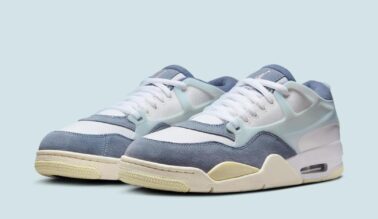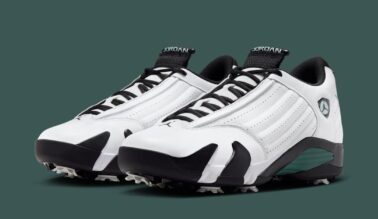This post may contain affiliate links. Please read our disclosure policy.
As we inch closer and closer to its official release, the highly anticipated Air Jordan 2011 continues to garner a lot of attention and rightfully so. Lately, Dwyane Wade has had a couple of monster games in this new signature, and the “Year of the Rabbit” version released earlier this week exclusively in China.
In preparation of its upcoming Stateside release, we put the Air Jordan 2011 through our vigorous performance test to see if it lived up to the hype. Can one tell the difference between the interchangeable soles? Did Jordan Brand top the Air Jordan 2009 and Air Jordan 2010 with this new creation? Find out the answer to these questions, among other inquiries, in our Air Jordan 2011 Performance Review below.
Strengths:
Versatility
Stability
Custom Fit
?From an art and science standpoint, the Air Jordan 2011 is all about the modularity piece underfoot?being able to choose your ride?? ? Tom Luedecke, Jordan Brand Senior Footwear Designer.
Can you imagine a player of Chris Paul’s stature posting up players twice his size deep in the paint? Or a big man like Shaq handling the ball on the perimeter calling out plays? Probably not (unless you’re watching an All-Star Game). However, there are some players that thrive and are successful at both games. Jordan Brand athletes Dwyane Wade and Carmelo Anthony are prime examples of players that can easily be effective using a perimeter-oriented game but can also mix it up and take advantage of smaller opponents by posting up deep in the paint as well. Likewise, the newly-designed Air Jordan 2011 can aid a player who wants to use their quickness and speed as an advantage but can also enhance the player that relies on explosion around the basket. Usually, a sneaker is ideal for one of the two described player types; but, the innovative Air Jordan 2011 appeals to both through its interchangeable soles. Yes, people. One shoe. Two soles.
Blue Sole (Be Quick): First off, one can definitely feel the difference between the interchangeable soles; yet, when sliding your foot into the blue sole-laced Air Jordan 2011,? you will automatically feel that it is the firmer and more responsive of the two. It actually plays lower to the ground which is definitely an advantage for those who thrive on the perimeter. One cannot be successful playing basketball standing straight up (defensively and offensively), therefore, the low-riding blue sole undoubtedly aids one’s ‘horizontal’ game. On the perimeter, a player uses a lot of lateral motion whether it is working off of a pick-and-roll or sliding your feet defensively, and the blue sole seems to possess a more ‘active’ feel to it. In other words, your foot feels more free, and you are able and more confident to cover ground quicker when using the blue sole. You can credit the heel and forefoot Zoom Air units for this advantage. As with previous Zoom Air laced sneakers, the Air Jordan 2011 feels very flexible and owns a lower profile when incorporating the blue sole. It provides a very stable wear and allows the foot no wiggle room when making impact-heavy, sudden moves such as cuts to the basket, hesitations and unexpected jolts.
Red Sole (Be Explosive): As stated earlier, there is day-and-night change when going from one interchangeable sole to the next. The red sole is so much more comfortable to the foot thanks to the Cushlon foam midsole. It is a much more softer ride than the blue sole and possesses an elevated surface for the foot. The ortholite sockliner also contributes to the softer, more bouncier feel of the red sole laced Air Jordan 2011. When playing under the basket, the wearer can benefit from a shoe that enhance one’s game vertically more than horizontally. In detail, vertical reaction time is important especially when jumping for a rebound, absorbing contact when attempting to draw a foul and/or blocking shot. Also, when landing from the previously-mentioned acts, the spring-like Cushlon midsole and 3/4 length Air unit are ideal for counteracting the maximum impact.
Besides the soles, the Air Jordan 2011 is an overall great, form-fitting sneaker. As stated by Co-Designer Tom Luedecke, the lacing construction actually extends underneath the foot which gives the wearer an extremely lockdown feel around the entire foot. When lacing the Air Jordan 2011 up properly, the laces (and mesh booty construction) seem to firmly grab and interlock the foot which provides a undeniable, secure feel.
Weaknesses:
Durability
The Air Jordan 2011 ranks very high in fit, aesthetics and performance. With that said, there is not too much to complain about. However, if we had to nitpick and point something out, durability would be of small concern. Much like the Jordan CP3.IV, the Air Jordan 2011 creased around the toe area after only a few wears. It only leaves us to wonder how long this shoe can last over a high school/college schedule (30+ games), let alone an NBA schedule (82+ games).
Overview: Versatility is the driving force behind the Air Jordan 2011. It has been a very long time since the sneaker community has witnessed a shoe that can benefit all shapes, sizes and types of players like the Air Jordan 2011. The interchangeable, modular sole element is nothing less than innovative and can withstand the rigors of a perimeter and/or under-the-basket oriented game.
The Air Jordan 2011 will hit retailers on February 19, 2011, for $170.
Click here to view detailed photos of upcoming Air Jordan 2011 colorways.



